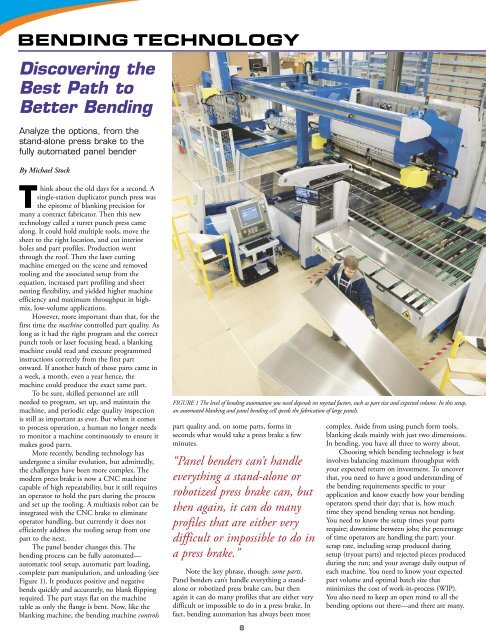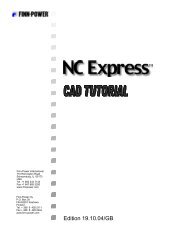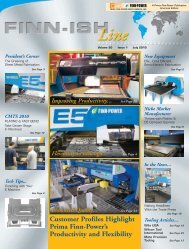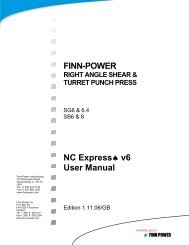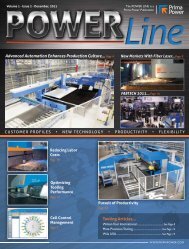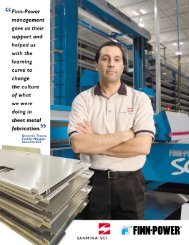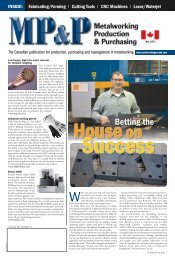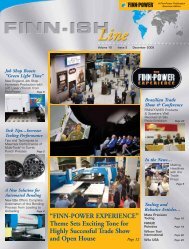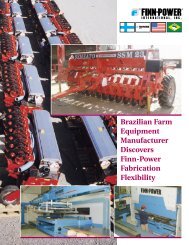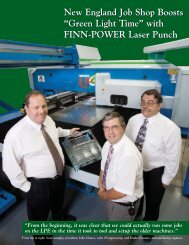Volume 20 Issue 2 - Finn-Power International, Inc.
Volume 20 Issue 2 - Finn-Power International, Inc.
Volume 20 Issue 2 - Finn-Power International, Inc.
You also want an ePaper? Increase the reach of your titles
YUMPU automatically turns print PDFs into web optimized ePapers that Google loves.
BENDING TECHNOLOGY<br />
Discovering the<br />
Best Path to<br />
Better Bending<br />
Analyze the options, from the<br />
stand-alone press brake to the<br />
fully automated panel bender<br />
By Michael Stock<br />
Think about the old days for a second. A<br />
single-station duplicator punch press was<br />
the epitome of blanking precision for<br />
many a contract fabricator. Then this new<br />
technology called a turret punch press came<br />
along. It could hold multiple tools, move the<br />
sheet to the right location, and cut interior<br />
holes and part profiles. Production went<br />
through the roof. Then the laser cutting<br />
machine emerged on the scene and removed<br />
tooling and the associated setup from the<br />
equation, increased part profiling and sheet<br />
nesting flexibility, and yielded higher machine<br />
efficiency and maximum throughput in highmix,<br />
low-volume applications.<br />
However, more important than that, for the<br />
first time the machine controlled part quality. As<br />
long as it had the right program and the correct<br />
punch tools or laser focusing head, a blanking<br />
machine could read and execute programmed<br />
instructions correctly from the first part<br />
onward. If another batch of those parts came in<br />
a week, a month, even a year hence, the<br />
machine could produce the exact same part.<br />
To be sure, skilled personnel are still<br />
needed to program, set up, and maintain the<br />
machine, and periodic edge quality inspection<br />
is still as important as ever. But when it comes<br />
to process operation, a human no longer needs<br />
to monitor a machine continuously to ensure it<br />
makes good parts.<br />
More recently, bending technology has<br />
undergone a similar evolution, but admittedly,<br />
the challenges have been more complex. The<br />
modern press brake is now a CNC machine<br />
capable of high repeatability, but it still requires<br />
an operator to hold the part during the process<br />
and set up the tooling. A multiaxis robot can be<br />
integrated with the CNC brake to eliminate<br />
operator handling, but currently it does not<br />
efficiently address the tooling setup from one<br />
part to the next.<br />
The panel bender changes this. The<br />
bending process can be fully automated—<br />
automatic tool setup, automatic part loading,<br />
complete part manipulation, and unloading (see<br />
Figure 1). It produces positive and negative<br />
bends quickly and accurately, no blank flipping<br />
required. The part stays flat on the machine<br />
table as only the flange is bent. Now, like the<br />
blanking machine, the bending machine controls<br />
FIGURE 1 The level of bending automation you need depends on myriad factors, such as part size and expected volume. In this setup,<br />
an automated blanking and panel bending cell speeds the fabrication of large panels.<br />
part quality and, on some parts, forms in<br />
seconds what would take a press brake a few<br />
minutes.<br />
“Panel benders can’t handle<br />
everything a stand-alone or<br />
robotized press brake can, but<br />
then again, it can do many<br />
profiles that are either very<br />
difficult or impossible to do in<br />
a press brake.”<br />
Note the key phrase, though: some parts.<br />
Panel benders can’t handle everything a standalone<br />
or robotized press brake can, but then<br />
again it can do many profiles that are either very<br />
difficult or impossible to do in a press brake. In<br />
fact, bending automation has always been more<br />
8<br />
complex. Aside from using punch form tools,<br />
blanking deals mainly with just two dimensions.<br />
In bending, you have all three to worry about.<br />
Choosing which bending technology is best<br />
involves balancing maximum throughput with<br />
your expected return on investment. To uncover<br />
that, you need to have a good understanding of<br />
the bending requirements specific to your<br />
application and know exactly how your bending<br />
operators spend their day; that is, how much<br />
time they spend bending versus not bending.<br />
You need to know the setup times your parts<br />
require; downtime between jobs; the percentage<br />
of time operators are handling the part; your<br />
scrap rate, including scrap produced during<br />
setup (tryout parts) and rejected pieces produced<br />
during the run; and your average daily output of<br />
each machine. You need to know your expected<br />
part volume and optimal batch size that<br />
minimizes the cost of work-in-process (WIP).<br />
You also need to keep an open mind to all the<br />
bending options out there—and there are many.


